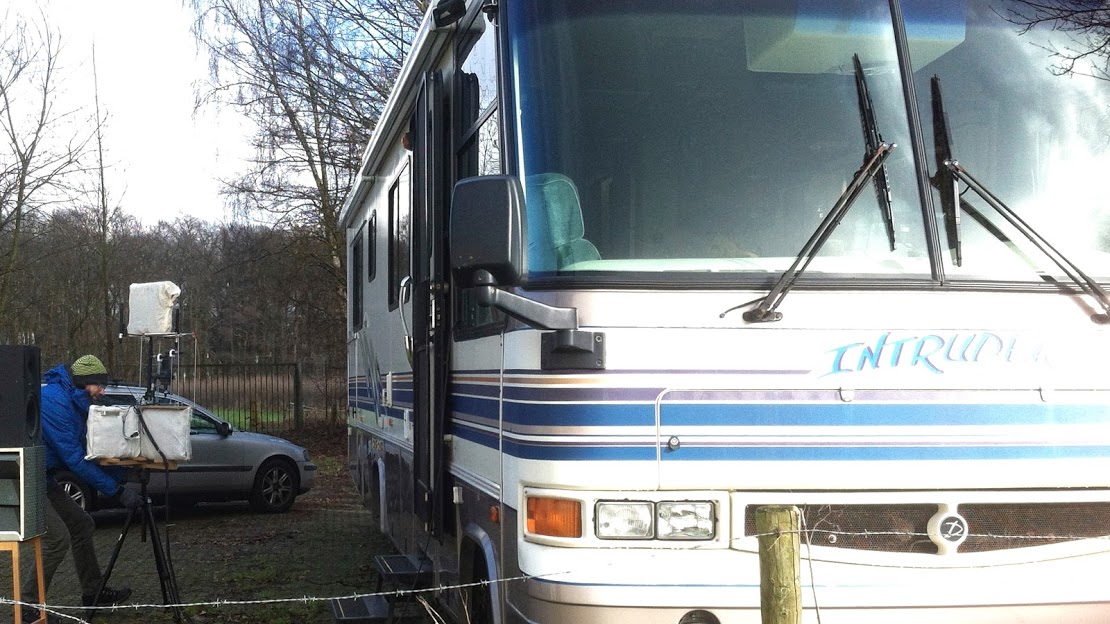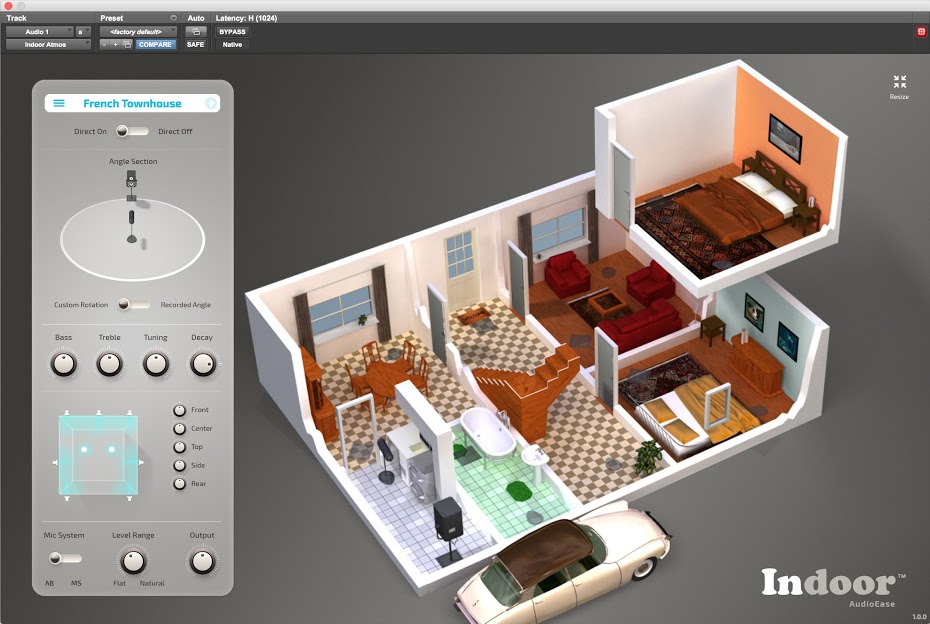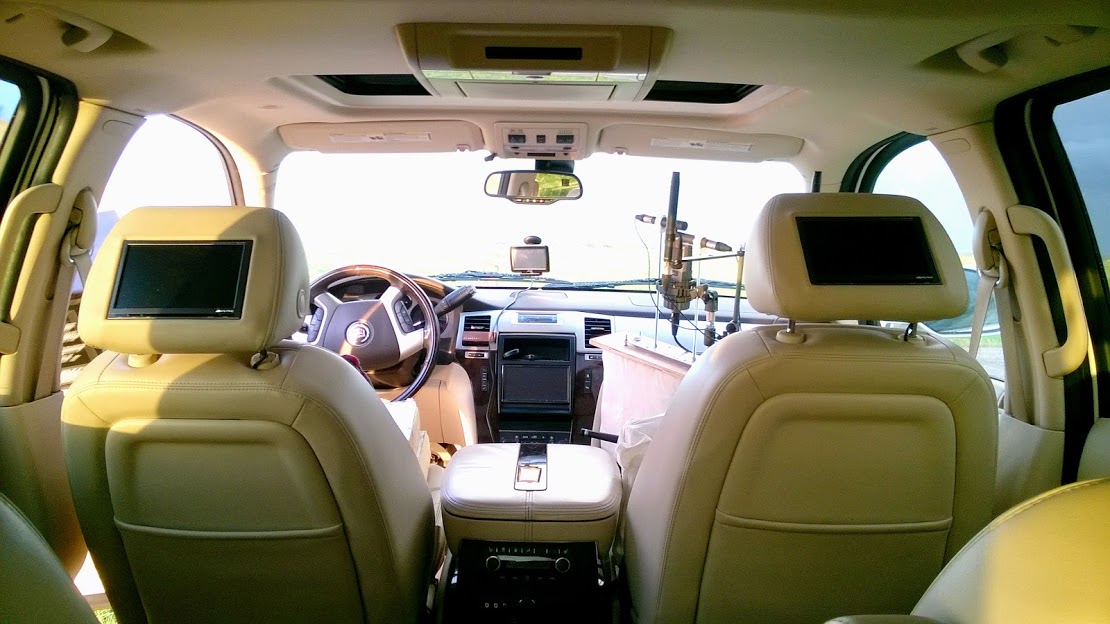New Software Review: Indoor Post-Production Reverb by Audio Ease
It’s no secret that I’m a big Audio Ease fan. Ever since I heard the early versions of Altiverb and its true-to-life Impulse Responses in the recording studio, I was hooked.
Convolution reverb isn’t for everyone, and it isn’t for all applications. But for the records I was making, and more recently the films and television projects I’ve been mixing, I’ve always been able to find the perfect sounding reverb in Altiverb. I’ve had the pleasure of creating Impulse Responses for Audio Ease for their Altiverb 7 plug-in, as well as for private recording studio and producer uses.
As a sound designer and mixer for post production projects, one of my biggest challenges is figuring out how to put sounds in rooms and make them feel natural. Music beds, door knocks, background chatter, as well as plates and dishes all need to live in the space that exists on screen, even if they’re added during the sound design and mix process. Audio Ease has created a plug-in called Indoor which addresses all of these issues, and packs them into an incredibly easy-to-use plug-in that sounds unbelievable. Let’s see what Indoor is all about!
Features
Indoor is a convolution reverb plug-in built for audio post production, film and TV projects.
What is a convolution reverb? In its simplest form, convolution reverb uses real rooms and acoustic spaces sampled with sweep tones that are converted into impulse responses (IRs). These IRs are the heart of the reverb engine that makes dry recordings sound as if they inhabit the rooms in which they are placed.
Indoor runs on Mac OS X 10.8+ and Windows 7-10; AAX Native / DSP at 32 and 64bits. Channel configurations include Mono, Stereo, LCR, Quad, 5.0, 5.1, 7.0 DTS, 7.1 DTS as well as 9.0 and 9.1 Dolby Atmos.
Before we dive into the mechanics of Indoor, let’s see what’s under the hood. The core sound of Indoor was created using a sophisticated rig of nine microphones. Four Omni mics are arranged in quad for surround, three microphones are placed in a traditional Mid/Side (M/S) configuration, and then finally two additional Omni mics are placed up top near the ceiling for Dolby Atmos channels.
These microphones capture sweep tones in each of these positions, which are then made into the IRs available within Indoor. According to the Audio Ease manual, when you select a system using the Mic System selector, you select the corner channels (Left, Right, Left Surround, Right Surround). Any side surround and center channels are then picked from the other system: Mid/Side (M/S).
I highly recommend that anyone interested in Indoor watches Arjen from Audio Ease’s fantastic intro video.
In Use
There’s no denying that when first opening Indoor, you know you’re in the future. The GUI itself features three-dimensional layouts of spaces that look incredibly realistic and similar in detail to current-day video games.
The spaces available in Indoor include:
- Empty House
- Yacht
- Forest Bungalow
- Auto Workshop
- Hotel
- Log House
- Restaurant
- RV Damon Intruder
- SUV Cadillac Escalade
- French Townhouse
It’s worth noting that perception is everything in sound design for post. Ask any sound designer who has used the sound of bacon frying in a pan as a substitute for rain and they’ll tell you that where a sound actually comes from often has no correlation to what it is representing on screen. This notion is important to bear in mind when searching through the spaces available in Indoor and imagining what they could be used for in any number of circumstances.
For instance, it’s totally plausible that you could use the interior of the SUV as a substitute for a closet, or the tiled kitchen in the restaurant as a gymnasium or a pool. Many spaces that are vastly different in look and feel are often very similar acoustically.
Inside each virtual space is a microphone and a speaker. A typical space has four to eight core mic and speaker positions where both the microphone and speaker are located near each other and move as a group. But the fun really starts when you begin moving the microphone and speaker independently of each other.
The layout takes a little getting used to in order to figure out what you’re really doing when you click around the room. However, once you get acclimated to the way the plug-in behaves, it’s incredibly easy to quickly place a speaker in one part of the room, and select a microphone from further away (or even on another floor!).
The wealth of sonic possibilities available in Indoor comes into greater focus when you start playing with opening and closing doors in between the sound path of the speaker and microphone. This greatly changes the tonal characteristics of the sound being processed. With doors closed, the music, FX and dialogue sound more dampened and muffled. As doors are opened, the sound becomes crisper and more wide open sonically.
It’s not uncommon when working with sound for picture that a scene will take place in one room and music or dialogue will be audible from another room. With Indoor, you can achieve this effect with just a few clicks.
Bonus points to Audio Ease for being able to select the radio in the restaurant and the TV in the hotel room as your speaker choice. Both of these options, however, felt almost like hidden Easter eggs and were not easily identifiable as speaker options. These options are noted in the user guide, however.
Indoor functions primarily in two ways: Direct Mode On and Off. With Direct Mode On (default), Indoor sounds most natural. The plug-in gives you an interactive 360-degree speaker vs. microphone placement control. This allows you to move the speaker in a complete circle around the microphone in real time while listening in either stereo or surround. Doing this affects both the timbre and panning of the sound source in relation to the microphone.
It’s worth noting that even while monitoring in stereo, the “rear” positions sound muffled and behind you in a way that still feels authentic. As the user guide mentions, with Direct Mode On, what you see is what you hear. If the speaker is to the right of the microphone, then that is what you’ll hear. If you open a door or move the speaker closer, it gets louder.
It’s also important to realize that when you are manipulating the 360-degree microphone, what you are essentially doing is rotating the entire microphone rig in the room it was recorded in!
With Direct Mode Off, you get more traditional wet/dry and pre-delay controls that are familiar to reverbs. Direct Mode Off functions more traditionally with tracks being sent to Indoor from sends. This allows you to use your send pan to place your tracks accordingly within Indoor. Combined with the Spread knob, this is a convenient way to create localized reverb and atmospheres that match your on-screen sources.

Audio Ease went to great lengths to bring total authenticity to their simulations of real acoustic spaces within Indoor.
A note on the Level Range feature: As mentioned in the Indoor manual, all impulse responses were recorded using a single mic preamp gain setting. As a result, all natural levels based on the location of the speaker versus the microphone have been preserved. So, if your speaker is downstairs and your microphone is upstairs behind two closed doors, the sound is going to be much quieter than if the speaker and microphone are quite close to each other. The Level Range knob solves this issue by providing a flatter volume response for all mic placements regardless of distance between the speaker and the microphone, simply by turning counter clockwise towards “Flat.” This is truly a unique and extremely helpful feature.
One of the most impressive features of Indoor stems from the two main Mic Systems you have access to: A/B and M/S (Mid/Side). The A/B system is the four-way omni mic setup from the mic rig. The MS is the three-mic Mid/Side configuration. These two setups sound uniquely different from each other.
The A/B system sounds full and wide, and at times a bit on the muffled side. The MS system conversely is sharper and more focused. I have found both systems to be uniquely useful on a case-by-case basis when mixing.
I used both mic systems a great deal on two feature films I mixed this year: Do You Take This Man and Bwoy, both starring Anthony Rapp. In Bwoy, there was one shot in particular when Anthony’s character is very angry in the basement of his house, and the scene cuts to his wife upstairs, but we’re still hearing Anthony yelling in the basement. This is a perfect situation for Indoor, where I can take Anthony’s direct dry track and process it through closed doors to perfectly simulate the sound of Anthony being in the basement while we’re upstairs listening.
While demoing Indoor, I had the pleasure of bouncing some thoughts and ideas off of my friend, sound mixer Lawrence Everson who recently mixed the fabulous Contemporary Color documentary. One thing I wanted Lawrence to do with Indoor was put it through the ringer of automation and see how it holds up. His feedback didn’t disappoint:
“I was very impressed by their automation,” Lawrence noted, “which is sometimes troublesome with complex reverb programs. Audio Ease notes that a lot of work went into making Indoor automatable without clicks or pops. True to their word, I tried some sessions where I really spammed the automation and switched dozens of parameters rapidly — including the global room spaces — and everything switched seamlessly and without any noticeable interruption of the sound sources or clicking or popping. I was very impressed. In my tests, the automation abilities appeared flawless.”
That’s certainly a fantastic testimonial, and one I strongly agree with. Every automation test I put Indoor through passed with flying colors.
Summing it Up
While Indoor is not the most inexpensive plug-in on the market, it’s important to realize that you are getting all of the following:
- 1,000 new impulse responses using two complete microphone systems.
- The ability to move around each space and automate microphone and speaker movements within your DAW seamlessly.
- AAX and DSP support.
- 9 channels including 7.0 plus Dolby Atmos.
Indoor is one of those plug-ins that you will likely never “hear” when you’re watching a movie or a TV show. The beauty of Indoor is the team at Audio Ease has created a world that the sound designer can inhabit within the plug-in, where they can access all the tools needed to sculpt and shape any sound in a myriad of ways.
The key with Indoor is it’s quick and easy to achieve stunningly realistic results. This allows the user to dial in the sound they need, fit it into their mix and move on. I’m really looking forward to the next challenge that awaits, giving me the opportunity to use Indoor to amaze my clients with what is possible nowadays in post production.
At $795 (€699) Indoor is no small expense, however it is surely a worthwhile investment for any sound designer who aims to work more efficiently. Well done Audio Ease!
Zach McNees is a Brooklyn-based producer/engineer/mixer and live recordist whose work includes Björk, Rob Thomas, The Gregory Brothers, Pixies, and many more. Zach’s post-production work includes House Hunters International (HGTV), VICE (HBO), All-American Makers (Science Channel) and the award winning documentary short “For The Love of Dogs”. Get in touch with Zach at http://www.zachmcnees.com.
Please note: When you buy products through links on this page, we may earn an affiliate commission.








